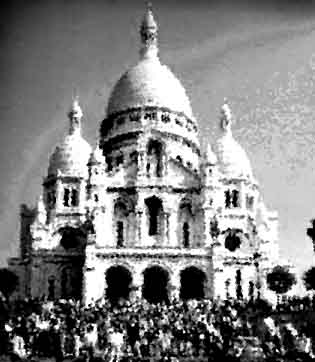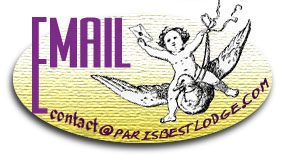
Montmartre
Mounting Montmartre
 One does not merely visit Montmartre, one climbs it. The standard
approach is from the South, via Metro Anvers or Metro Abbesses,
although other directions provide interesting, less crowded climbs.
From Metro Anvers the walk up to the orned switchbacked stairway
is short but sometimes overcrowded with tourists and associated
commerce. The longer climb from Metro Abbesses, also the safest at
night, leads one through more worthwhile cafés and shops. Follow
rue de la Vieuville to rue Drevet, turning right on rue Gabrielle and
left up the stairs to rue du Cardinal Dubois. For an easier ascent,
take the glass-covered funiculaire from the base of rue Tardieu.
Reminiscent of a ski lift, it is operated by the ratp and can be used
with a normal metro ticket.
One does not merely visit Montmartre, one climbs it. The standard
approach is from the South, via Metro Anvers or Metro Abbesses,
although other directions provide interesting, less crowded climbs.
From Metro Anvers the walk up to the orned switchbacked stairway
is short but sometimes overcrowded with tourists and associated
commerce. The longer climb from Metro Abbesses, also the safest at
night, leads one through more worthwhile cafés and shops. Follow
rue de la Vieuville to rue Drevet, turning right on rue Gabrielle and
left up the stairs to rue du Cardinal Dubois. For an easier ascent,
take the glass-covered funiculaire from the base of rue Tardieu.
Reminiscent of a ski lift, it is operated by the ratp and can be used
with a normal metro ticket.
Every sunday at 2h30pm from may 1 to oct 15, the
city organizes historic 2hr walking tours in french of montmartre,
which
allow a unique view into some of the less-touristed spots of the butte.
Basilique du Sacre-Coeur
Metro : Anvers, Abbesses or Chateau-Rouge
The Basilica of the Sacred Heart is like an exotic
headdress floating above Paris. In 1873, the Assemblée
Nationale selected the birthplace of la Commune as the location for
Sacré Coeur, "in witness of repentance and as a symbol of hope",
although politician Eugene Spuller called it "a monument to civil
war". The catholic establishment hoped that the Sacré
Coeur would "expiate the sins" of France after the bloody civil war in
which thousands of Communards were massacred by government
troops. After a massive fund-raising effort, the basilica was
completed in 1914 and consecrated in 1919. Its hybrid style of
onion domes, arches, and white color set it apart from the smoky grunge
of most parisian buildings. Most striking inside the basilica are the
mosaics, especially the depiction of Christ on the ceiling of the Mural
of the Passion at the back of the altar. The narrow climb up the dome
offers the highest vantage point in paris and a view that stretches as
far as 50 km on clear days. Farther down, the crypt contains a relic of
what many believe to be a piece of the sacred heart of Christ. While
the views up the grassy slopes to the Basilica are among the most
beautiful in Paris, the streets beneath the winding pedestrian pathways
leading up to the Basilica are hideously over-touristed. To the
circumvent the onslaught, walk up rue des Trois Freres instead.
Likewise, try to avoid the sacrilegiously commodified streets
surrounding Sacre-Coeur.
Lapin Agile
Metro : Lamarck-Caulaincourt. 22, rue des saules.
Still going strong among quaint shuttered
houses is the Lapin Agile cabaret. Frequented by Verlaine, Renoir,
Modigliani, and Max Jacob, the establishment was first known as
the "Cabaret des Assassins" until Andre gill decorated its facade with
a painting of a lapin (rabbit) balancing a hat on its head and a bottle
on its paw. The cabaret immediately gained renown as the "lapin
à gill". By the time Picasso began to frequent the
establishment, walking over from his first studio at 49, rue Gabrielle,
the name had contracted to "lapin Agile".
Place du Tertre
Metro : Abbesses.
One of the most heinously over-touristed spots in
the18eme, place du Tertre teems with absymal chintz artwork by hack
street artists., hordes of pushy portrait painters, and has-been
cafés. But the place was once the haunt of artists and
intellectuals, and the cheapness of the area had not destroyed its
celebrated vista of the butte.










 One does not merely visit Montmartre, one climbs it. The standard
approach is from the South, via Metro Anvers or Metro Abbesses,
although other directions provide interesting, less crowded climbs.
From Metro Anvers the walk up to the orned switchbacked stairway
is short but sometimes overcrowded with tourists and associated
commerce. The longer climb from Metro Abbesses, also the safest at
night, leads one through more worthwhile cafés and shops. Follow
rue de la Vieuville to rue Drevet, turning right on rue Gabrielle and
left up the stairs to rue du Cardinal Dubois. For an easier ascent,
take the glass-covered funiculaire from the base of rue Tardieu.
Reminiscent of a ski lift, it is operated by the ratp and can be used
with a normal metro ticket.
One does not merely visit Montmartre, one climbs it. The standard
approach is from the South, via Metro Anvers or Metro Abbesses,
although other directions provide interesting, less crowded climbs.
From Metro Anvers the walk up to the orned switchbacked stairway
is short but sometimes overcrowded with tourists and associated
commerce. The longer climb from Metro Abbesses, also the safest at
night, leads one through more worthwhile cafés and shops. Follow
rue de la Vieuville to rue Drevet, turning right on rue Gabrielle and
left up the stairs to rue du Cardinal Dubois. For an easier ascent,
take the glass-covered funiculaire from the base of rue Tardieu.
Reminiscent of a ski lift, it is operated by the ratp and can be used
with a normal metro ticket.






